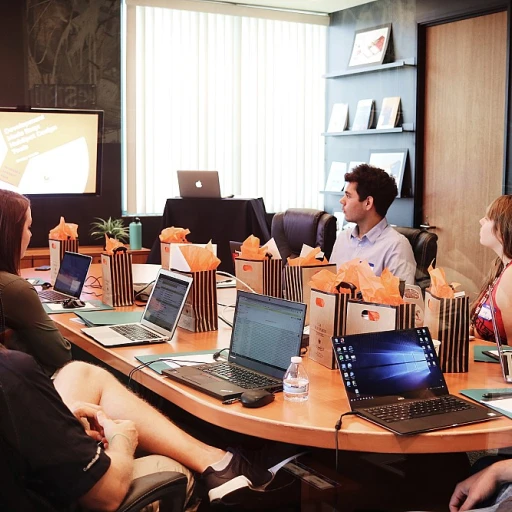
Understanding High Potential Employees
What Defines a High Potential Employee?
Understanding high potential employees is essential for businesses aiming to capitalize on their skilled workforce. High potential employees, often referred to as "HiPos," are those who demonstrate the ability to grow and contribute significantly to the organization. They exhibit exceptional skills in their current roles, show a strong capacity for future development, and align with the company’s strategic goals. When identifying these standout individuals, organizations often consider several factors:- Performance and Results: A high potential employee consistently delivers excellent results and exceeds performance expectations.
- Adaptability and Learning Agility: They possess the ability to quickly learn new skills and adapt to changing business environments.
- Leadership Potential: These employees often demonstrate leadership qualities, even if not yet in a leadership role.
- Commitment to Company Goals: High potential employees are aligned with the company’s mission and values, driving engagement and productivity.
Challenges Faced by High Potential Employees
Identifying and Overcoming Challenges
High potential employees are often seen as the future leaders of a business, equipped with the skills and ambition necessary for top performance. However, they face a unique set of challenges that can hinder their development and impact. Recognizing these challenges is vital for effective talent management and employee development.
One major challenge is the pressure to consistently perform at a high level. High potentials, often identified early in their careers, may encounter unrealistic performance expectations. This can lead to stress and burnout if not properly managed through supportive resources like performance management training programs. Such programs can equip them with tools to manage stress and structure their goals effectively.
Balancing Development and Responsibilities
Another challenge involves balancing their current job responsibilities with ongoing training and skills development. High potential employees need to continuously enhance their capabilities through comprehensive courses and learning platforms. This is where an effective learning management system (LMS) such as TalentLMS becomes crucial, offering customized learning paths to meet individual needs and ensuring professional development is aligned with business objectives.
- Access to Training: Seamless access to training development and content is crucial for balancing work and career growth.
- Time Management: Development LMS platforms can support efficient management of time by offering flexible learning options.
Fostering Collaborative Learning Environments
Creating a collaborative learning environment is another challenge facing high potential employees. Many benefit from engaging with mentors or peers through systems that promote collaborative learning. A learning platform that supports interaction and collaboration can enhance the development journey, ensuring employees feel supported and encouraged.
Tackling these challenges effectively can lead to improved employee engagement and retention, ultimately benefiting both the individuals and the organization. The right tools and strategies, including tailored performance management training and robust learning management systems, can make a significant difference in turning potential into performance.
The Role of LMS Talently in Talent Development
Empowering Talent through Comprehensive Learning Tools
In today's fast-paced business environment, the necessity of equipping high potential employees with the right tools for success cannot be overstated. This is where LMS Talently plays a critical role in the talent development journey. This learning management system (LMS) provides a robust platform that caters to both organizational needs and personal growth, ensuring high performers remain engaged and continuously develop their skills. A standout feature of LMS Talently is its ability to integrate customized content that aligns with specific business strategies. By doing so, companies can effectively build a strong talent pipeline. This approach to talent management involves offering highly relevant courses that develop the employee's skill set in alignment with the organization’s objectives. The LMS platform facilitates collaborative learning, allowing users to interact with peers, enhancing their professional development through shared insights and experiences. Moreover, the system is designed to be user-friendly, ensuring that employees can easily access a variety of courses tailored to their development needs. This ease of use encourages continuous engagement and learning, which translates into improved performance and business outcomes. By utilizing a comprehensive development LMS like Talently, companies not only foster talent growth but also secure a competitive advantage in the market. Furthermore, to measure the effectiveness of these training development initiatives, LMS Talently offers detailed analytics that track the progress of each employee. This data-driven approach helps organizations evaluate their strategies and make informed decisions about future training needs, ensuring that high potential employees remain the top performers within their fields.Strategies for Engaging High Potential Employees
Crafting a Stimulating Environment for Talent Nurture
Engaging high potential employees requires a strategic approach within an organization. Companies must foster an environment that prioritizes both professional development and personal growth, ensuring that these valuable individuals remain motivated and invested in their roles. Key strategies include:- Comprehensive Training and Development Programs: Implementing robust training development initiatives can significantly enhance an employee's skill set. Utilizing a learning management system (LMS), like Talently, allows companies to design personalized learning pathways tailored to the unique skills and aspirations of their high potential employees. This not only helps in the growth of talent but also aligns employee development with the organization's goals.
- Access to Diverse Learning Content: A diverse array of content accessible through a learning platform ensures employees are equipped with the skills needed to advance their careers. Managers should encourage continuous learning through courses available on the platform, which contributes directly to talent development.
- Opportunities for Collaborative Learning: Creating spaces for employees to engage in collaborative learning activities can foster a supportive community within the organization. Interaction and knowledge exchange among peers can amplify learning and sharpen employee capabilities.
- Effective Talent Management and Performance Feedback: Regular performance appraisals and constructive feedback are crucial components of talent management. They provide insights into an employee's progress, allowing personalized adjustments to their development plan, enhancing both immediate performance and long-term growth.
- Incentives for Continued Engagement: Establishing incentives for professional development encourages employees to remain invested in their growth journey. Rewards could range from recognition in company newsletters to more substantial benefits like funding for continuing education programs.
Measuring Success: Evaluating the Impact of LMS Talently
Key Metrics for Evaluating Learning Management Systems
When assessing the effectiveness of LMS Talently for high potential employees, several key metrics emerge as crucial indicators of success. Here’s a closer look at some of the essential metrics you should consider:
- Engagement and Participation Rates: It's vital to measure how often and how engaged employees are with the learning platform. High participation and engagement levels indicate that the learning management system is successful in keeping employees interested and invested in their professional development.
- Skill Acquisition and Improvement: One clear measure of success is the extent to which employees acquire new skills or improve existing ones through the courses offered by the platform. Tracking progress in skills can provide insight into the effectiveness of the training and development programs.
- Content Utilization: Analyzing which learning materials are most frequently accessed can help in understanding what works well within the system and where improvements might be necessary. This aligns with the broader goals of talent development.
- Performance Improvements: Changes in employee performance after participating in programs offered by LMS Talently can be a powerful indicator of the platform's impact. Tracking such improvements can help in demonstrating ROI in training and development initiatives.
- Feedback and Satisfaction Levels: Gathering user feedback and satisfaction scores can provide crucial qualitative data that complements quantitative metrics. Understanding user experience helps in honing and tailoring the ongoing development of the learning platform.
Measuring these metrics provides a comprehensive view of LMS Talently's impact on talent management and employee development. By focusing on these key metrics, organizations can ensure that their strategic investments into learning and professional development initiatives are delivering the desired outcomes and paving the way for future advancements.
Future Trends in High Potential Employee Development
Emerging Trends in Maximizing Employee Potential
As businesses continue to evolve in the digital age, the avenues for nurturing high potential employees are continually expanding. The future holds promising trends in employee development that harness technological advancements and innovative strategies.- Personalized Learning Experiences: Leveraging data analytics, learning management systems can offer personalized learning paths tailored to the unique goals and skills of each employee. This targeted approach enhances engagement and ensures employees acquire crucial competencies effectively.
- Increased Focus on Collaborative Learning: Collaboration is becoming a cornerstone in learning environments, fostering a shared knowledge culture. By integrating collaborative learning tools, organizations can facilitate real-time interaction among peers, improving skills across teams.
- Integration of AI and Machine Learning: AI-driven insights are pivotal in identifying training needs and predicting the future skill requirements. This foresight enables managers to chart strategic learning paths and magnify the impact of talent development initiatives.
- Gamification in Training Programs: Incorporating interactive elements and game-based content keeps employees engaged, making learning processes enjoyable and impactful. Gamified systems can transform mandatory training into compelling journeys of growth.
- Mobile-First Learning Platforms: With the rise of remote work, mobile accessibility in LMS platforms becomes critical. Offering courses and training content on mobile devices ensures learning is flexible and readily accessible, regardless of location.
- Emphasis on Soft Skills Development: Future-ready companies emphasize soft skills alongside technical prowess. Soft skills such as communication, emotional intelligence, and adaptability are gaining prominence as they play crucial roles in enhancing overall employee performance.
- Continuous Feedback Mechanisms: Real-time feedback integrated within learning systems provides employees with immediate insights into their progress and areas for improvement. This nimble approach to feedback ensures ongoing growth and motivation.












